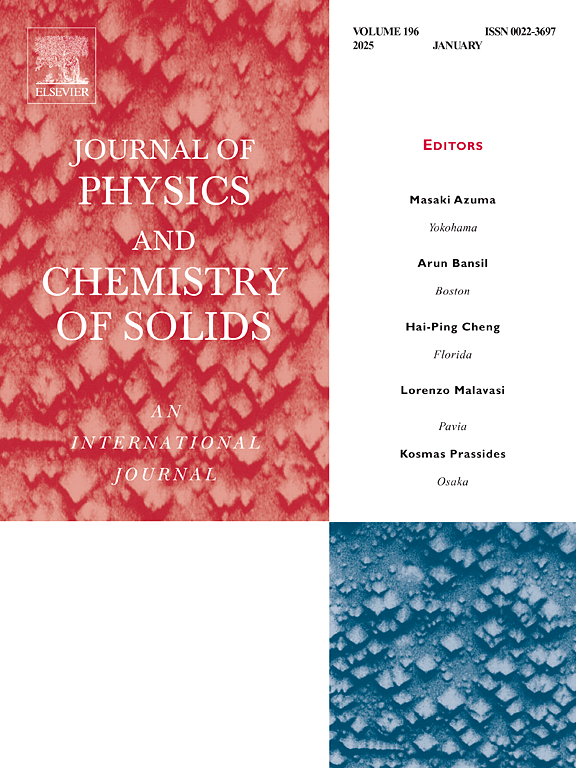Green-synthesized-AgS@CdS@MoSe2//交流不对称装置在可再生能源存储和氧还原反应中的应用
IF 4.9
3区 材料科学
Q2 CHEMISTRY, MULTIDISCIPLINARY
引用次数: 0
摘要
过渡金属二硫族化合物(TMDs)半导体材料是一种二维层状结构,由于其具有较大的表面积和电荷输运性,在储能系统中具有重要意义。在这项研究中,利用甜樱桃的绿色工艺合成了金属硫化物AgCdS纳米颗粒和复合材料AgCdS@MoSe2,然后将其用作超级电容器中的电极。采用三电极排列法研究了所有样品的电化学性能。在所有纳米复合材料中,AgCdS@MoSe2表现出优异的性能,在5 mV/s下的比容量(Csp)为865.3 F g−1,优于MoSe2和agcd。以AgCdS@MoSe2和活性炭(AC)为材料,分别以AgCdS@MoSe2和AC为正极和负极,构建了一种混合不对称装置。此外,AgCdS@MoSe2电极获得了94%的库仑效率,并在7000次循环后保持了90%的电容,显示出长时间的循环一致性。此外,AgCdS@MoSe2纳米复合电极用于氧还原反应。该电极在氮(N2)和氧(O2)气氛中表现出良好的性能。这些合成材料所显示的性能显示了它们作为超级电容器有利竞争者的潜力。本文章由计算机程序翻译,如有差异,请以英文原文为准。
Designing of Green-synthesized-AgS@CdS@MoSe2//AC asymmetric device for renewable energy storage and oxygen reduction reaction applications
Transition metal dichalcogenides (TMDs) semiconductor materials, a 2D layered structure, have obtained significance in energy storage systems due to their large surface area and charge transport. In this study, nanoparticles of the metal sulfides AgCdS and a composite AgCdS@MoSe2 were synthesized using a green process involving the sweet cherry, which was then utilized as electrodes to be implemented in supercapacitors. A three-electrode arrangement was employed to study the electrochemical performance of all samples. Among all nanocomposites, AgCdS@MoSe2 displayed superior performance, having a specific capacity (Csp) of 865.3 F g−1 at 5 mV/s, dominating the MoSe2 and AgCdS alone. AgCdS@MoSe2 and activated carbon (AC) were used to build a hybrid asymmetric device where AgCdS@MoSe2 and AC were used as positive and negative electrodes, respectively. Moreover, the AgCdS@MoSe2 electrode attained an outstanding 94 % coulombic efficiency and displayed prolonged cyclic consistency by retaining 90 % of its capacitance after 7000 cycles. Besides, the AgCdS@MoSe2 nanocomposite electrode is used for the oxygen reduction reaction. The electrode showed high performance in nitrogen (N2) and oxygen (O2) atmospheres. The performance shown by these synthesized materials displays their potential to be employed as favorable contestants for supercapacitors.
求助全文
通过发布文献求助,成功后即可免费获取论文全文。
去求助
来源期刊
CiteScore
7.80
自引率
2.50%
发文量
605
审稿时长
40 days
期刊介绍:
The Journal of Physics and Chemistry of Solids is a well-established international medium for publication of archival research in condensed matter and materials sciences. Areas of interest broadly include experimental and theoretical research on electronic, magnetic, spectroscopic and structural properties as well as the statistical mechanics and thermodynamics of materials. The focus is on gaining physical and chemical insight into the properties and potential applications of condensed matter systems.
Within the broad scope of the journal, beyond regular contributions, the editors have identified submissions in the following areas of physics and chemistry of solids to be of special current interest to the journal:
Low-dimensional systems
Exotic states of quantum electron matter including topological phases
Energy conversion and storage
Interfaces, nanoparticles and catalysts.

 求助内容:
求助内容: 应助结果提醒方式:
应助结果提醒方式:


